Exploring Dance Skate Wheels: A Comprehensive Guide
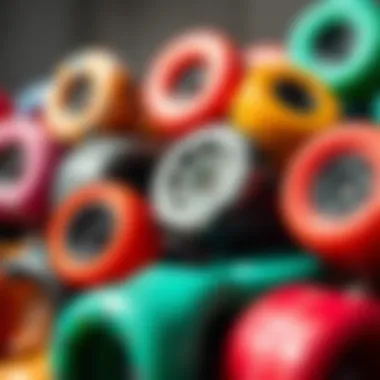

Intro
In the vibrant world of skating, dance skating holds a unique charm. It is not just about transportation or tricks; it’s an artistic expression that combines rhythm and movement. Central to this experience are the dance skate wheels, which are crucial for a skater's performance and enjoyment. This guide navigates the complexities of dance skate wheels, offering insights into their designs, types, and how they shape the skating experience.
Understanding these wheels is imperative for any skater looking to improve their skills. The wheels you choose can influence everything, from agility and stability to the overall feel of skating. With a plethora of options available, knowing what makes a good dance skate wheel can be daunting for novices and pros alike. Every detail counts, and every choice matters.
Wheels have evolved significantly over time, influenced by advancements in materials and design and enhancing performance capabilities. Skaters today have access to a variety of wheels tailored to different styles, terrains, and preferences. Discovering the fine nuances between them opens the door to enhancing your skating ability.
So, let’s dive into the world of dance skate wheels and unearth the essentials that can elevate your skating experience.
Foreword to Dance Skate Wheels
Dance skating is more than just a pastime; it's a vibrant expression of creativity and community. Central to this art form are dance skate wheels, which play a critical role in defining a skater's experience. Choosing the right wheels can significantly influence performance, ensuring that skaters not only glide smoothly but also execute intricate moves with precision. The wheels provide the necessary grip, speed, and control, impacting everything from casual flow to complex choreography. As we explore this topic, it's essential to grasp how wheel design and material can enhance skating enjoyment and safety, catering to a diverse range of skill levels and styles.
Historical Context of Dance Skating
Dance skating has its origins in the early 20th century, when roller rinks were all the rage. In the 1970s, as disco took hold, skaters infused their routines with dance moves. Back then, wheels were typically larger and made from hard materials, offering speed but not much else. However, as the culture evolved, so did the wheels. Adaptations were made to meet the needs of dancers who prioritized agility and flair over sheer velocity. With newer materials like polyurethane making their way into wheel production, a shift occurred, allowing for enhanced grip and better performance on various surfaces. The evolution reflects not only technological advancements but also the changing preferences of skaters who demand more from their equipment.
Significance of Wheels in Dance Skating
Wheels are the lifeblood of a dance skater's experience; they serve as the interface between the skater and the ground. Choosing the right wheels can mean the difference between a smooth glide and a dangerous slip. The material, size, and hardness of the wheels affect how a skater interacts with the surface beneath them.
- Grip and Control: Wheels made from softer compounds provide better traction, allowing skaters to maintain control during turns and intricate moves.
- Speed and Versatility: Harder wheels may glide fast but can feel slippery on uneven surfaces, compromising safety. Striking a balance in wheel hardness is key.
- Aesthetic Appeal: In addition to functionality, wheels come in various colors and designs, allowing skaters to express their unique style while dancing through life.
As the art of dance skating continues to flourish, understanding the significance of wheels is indispensable for both newcomers and veterans. By exploring these elements, we not only appreciate the technical aspects of skating but also celebrate the passion driving the dance skating community.
Types of Dance Skate Wheels
Dance skate wheels come in a variety of types, each with its own specific attributes that can greatly affect a skater's experience. Understanding the different types allows skaters to make informed decisions, ultimately enhancing their performance and enjoyment. Whether you're a new skater getting your feet wet or a seasoned pro, choosing the right wheels can mean the difference between a smooth ride and a bumpy one. This section dives deep into the core elements of dance skate wheels: their material composition and size variations.
Material Composition
The material used to create dance skate wheels is fundamental to their performance. Different materials provide various benefits and drawbacks, influencing aspects like grip, durability, and ride quality. Let’s break it down by material type:
Polyurethane
Polyurethane wheels have become the gold standard in dance skating. Known for their excellent grip, they are particularly good at adhering to different surfaces, which is a must for intricate dance moves. One of the standout characteristics is their ability to absorb shocks. This means skaters can glide smoothly, reducing the strain on their body.
One unique feature of polyurethane is its resilience to wear and tear. Unlike rubber, which may degrade over time, polyurethane wheels tend to maintain their shape and performance longer. However, if there’s a downside, it’s that they may not perform as well on slick, polished surfaces compared to harder materials.
Rubber
Rubber wheels offer another interesting option, known for their soft feel and exceptional shock absorption. This softness provides a comfortable ride, making them a favorite among beginners who are still finding their balance. Rubber wheels generally have a higher level of grip, which can be beneficial in maintaining control during spins and tricks.
However, while they’re great for indoor skating, rubber wheels can wear down faster when used on rough surfaces. This can mean they require more frequent replacements, which is an added cost to consider. They provide a specific feel, but might not suit everyone, especially those who love skating outdoors.
Plastic
Plastic wheels are often overlooked, but they bring their own advantages to the table. Typically more affordable than both rubber and polyurethane, plastic wheels can be a good entry point for new skaters not wanting to invest a fortune upfront. A key characteristic of plastic is its durability; these wheels can handle rough treatment and won’t easily lose their shape.
However, they come with a unique downside—they often lack grip compared to the other materials, which can make certain movements and stops less smooth. Skaters might find themselves slipping during tight turns. Thus, while they may be great as a starting point or for casual use, serious dancers may want to consider investing in more specialized wheels as their skills develop.
Size and Diameter Variations
Not all wheels are created equal, especially when it comes to size. The diameter of dance skate wheels significantly affects performance, making it a crucial aspect for skaters to consider. Ranging from standard to custom sizes, the dimensions can impact speed, control, and overall skating style.
Standard Sizes
Standard sizes are the bread and butter of dance skate wheels. Generally offered in diameters of about 57mm to 62mm, these sizes are widely accepted as the go-to option for most dancers. They strike a balance between speed and maneuverability. The uniformity yields consistency across different brands, making it easier for skaters to find replacements or upgrades when needed.
Yet, while standard sizes provide a common ground, they may not cater to everyone’s specific skating style. Skaters who prefer more agility may find smaller wheels more advantageous, while those looking for speed might opt for larger diameters.
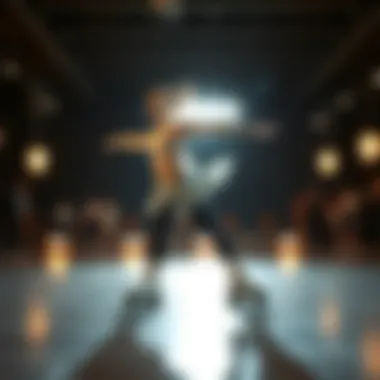

Custom Sizes
For those seeking a tailored experience, custom sizes allow skaters to pick the ideal diameter that suits their specific needs. Whether it’s for special performances or unique skating styles, custom wheel sizes can enhance personal preferences. The biggest advantage of opting for custom sizes is the ability to fine-tune performance according to one’s skating environment.
However, the uniqueness of custom sizes also comes at a price; they can be harder to source and may come with extended lead times. Additionally, compatibility with skate setups can be a concern. It’s essential for skaters to do their homework to avoid issues later on.
Impact on Performance
The size of dance skate wheels doesn't just serve aesthetic purposes; it carries real implications for performance. Larger wheels can translate to higher speeds, which is fantastic for long strides. However, they may compromise the ability to execute tight turns and spins, which are crucial in dance skating.
Conversely, smaller wheels afford greater agility and control, allowing for sharper movements. The impact they have on performance is worth considering—it affects not only how fast you can go but how well you can navigate intricate patterns.
Choosing the right size and material can be a game changer in one’s skating journey. Whether you want to glide smoothly or make precise moves, understanding the types of dance skate wheels sets the foundation for enjoyable skating experiences.
Performance Characteristics of Dance Skate Wheels
Understanding the performance characteristics of dance skate wheels is key for skaters looking to enhance their skills and experience. These wheels not only influence how a skater interacts with the surface but also affect agility, speed, and overall comfort. When selecting wheels, especially for dance skating, the right blend of grip, speed, and shock absorption can make a world of difference in executing turns and tricks smoothly. Below, we explore the primary elements that define a wheel's performance, making them indispensable for both novice and seasoned skaters.
Grip and Traction
The grip and traction of dance skate wheels can be likened to the tires on a car; they are what keep a skater firmly on the ground while making those intricate movements. The type of surface — whether hardwood or concrete — plays a significant role in determining the best wheel composition for optimum grip. For instance, wheels made from polyurethane generally provide better traction compared to those made from rubber, particularly on smooth surfaces. In dance skating, having wheels that grip well allows skaters to execute their moves with confidence, reducing the risk of slipping.
Moreover, the hardness of the wheels, measured on the durometer scale, significantly impacts traction. Softer wheels might provide more adherence on slippery or uneven surfaces but could slow skaters down. Conversely, harder wheels can increase speed but may compromise grip. Finding this balance is crucial, especially for dancers who require precision in their footwork.
"High-quality dance skate wheels can be the difference between a flawless routine and a trip to the floor!"
Skaters should perform trials with different wheel hardness levels to see what suits their style and environment best. A well-informed choice here sets the tone for how a skater dances through the rink, enhancing their overall performance.
Speed and Durability
When it comes to speed, the wheel's size and material composition directly affect how fast a skater can roll. Larger wheels typically allow for greater speeds, while smaller ones offer more control during intricate routines. Durability is also essential in this context; wheels need to withstand not just the rigors of regular use but also the wear caused by specific skating styles.
Investing in wheels known for their durability can save money in the long run. For instance, certain brands are renowned for their high-performance wheels made to last longer without compromising on speed. Polyurethane wheels generally strike a good balance between speed and durability, making them a popular choice among dancers.
Skaters should also consider the surface variables, as rough surfaces may cause wheels to wear down quicker. It’s wise to regularly inspect wheels for signs of damage or wear, an area often overlooked which could otherwise hinder performance.
Shock Absorption
Shock absorption plays a pivotal role in ensuring a smooth skating experience, especially when engaging in jumps or quick turns that generate impact. Wheels that effectively absorb shock can reduce potential injury risks, ensuring that the skater's joints experience less strain. Springs, grooves, or specific wheel designs can enhance shock absorption tremendously.
Different skating environments can also affect how much shock a wheel needs to absorb. For example, indoor rinks usually require wheels with more elasticity, while outdoor surfaces might benefit from sturdier constructions. The three-dimensional nature of dance skating means that unexpected movements demand reliable shock absorption, preventing wobbles or falls.
Selecting the Right Dance Skate Wheels
Choosing the right dance skate wheels can make or break your skating experience. This decision hinges on numerous factors that reflect not just your personal preferences but also your skating style and environment. Selecting wheels that fit your needs provides the foundational support for your skill development and enjoyment. In this section, we will break down these elements to help you make a concise choice that aligns with your skating goals.
Factors to Consider
When selecting dance skate wheels, various factors come into play, each influencing your performance and comfort on skates.
Skill Level
Your skill level is pivotal in the selection of dance skate wheels. Beginners often benefit from wider, softer wheels as they offer better grip and stability. As one progresses, the desire for faster speeds might come into play, leading to a preference for harder wheels. A common characteristic of wheels for beginners is their forgiving nature, allowing for an easier time navigating turns and maintaining balance. However, this advantage can turn into a disadvantage for advanced skaters who might find such wheels limiting in terms of speed and precision. Choosing wheels that complement your skill level ensures that you’re set up for success, avoiding frustration and promoting confidence.
Skating Style
The style in which you skate—be it rhythm, artistic, or free style—dictates the type of wheels that will serve you best. For instance, artists may prefer lighter wheels that allow for quicker movements and spins, whereas rhythmic skaters often opt for firmer wheels to maintain straight lines and achieve high speeds. Each style has its defining features: artists seek fluidity, while free style skaters thrive on versatility. The wrong choice here could mean the difference between a graceful performance and a clumsy outing. Skaters must consider which attributes apply best to their chosen style to enhance overall performance.
Environment
Where you skate also plays a crucial role in determining wheel selection. For urban environments with rough surfaces, softer wheels are beneficial as they absorb shocks better, leading to a smoother ride. Conversely, those skating on smoother indoor surfaces may prefer harder wheels, which facilitate speed and trick execution. The unique characteristic of an environment can have profound impacts; an indoor rink will necessitate a different wheel setup compared to an outdoor park. Skaters must adapt their wheel choices in accordance to their frequently skated locales to maximize performance and minimize wear.
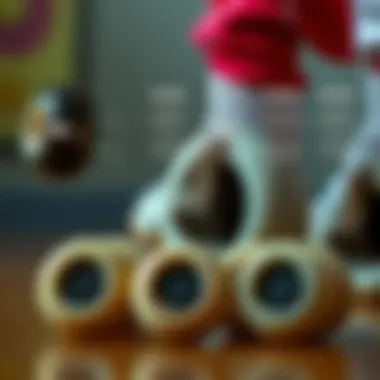
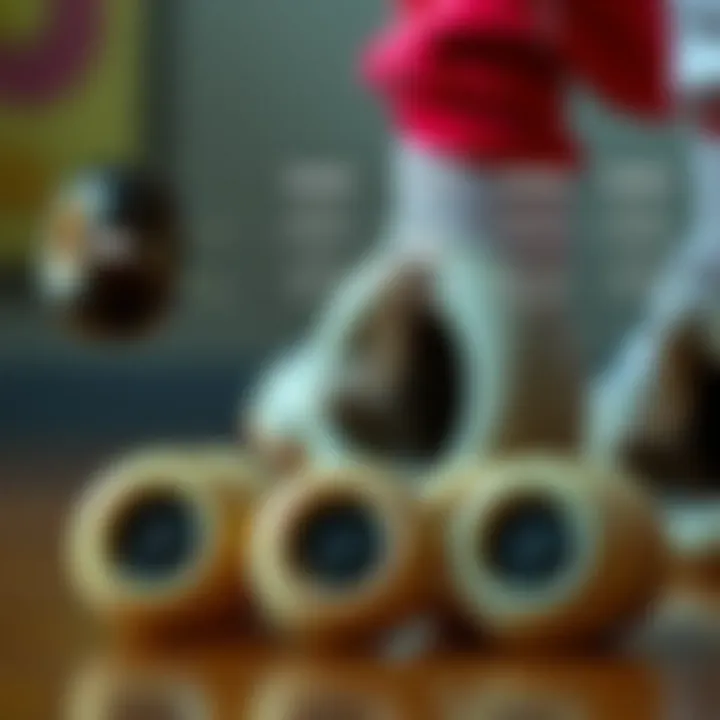
Expert Recommendations
To navigate your choices effectively, it could be beneficial to consult seasoned skaters and industry experts who can provide insight based on firsthand experience. Many professionals recommend testing various types of wheels to understand how each feels in action. Additionally, seeking advice from specialty skate shops can uncover features of wheels you may not have considered, ensuring that every aspect of your skating is geared towards optimal performance. > "Choosing the right wheels isn't just about preference— it's about enhancing your skillset and having good times on the dance floor!"
In wrapping this section up, remember that selecting the right wheels is a personalized endeavor. Years of evolution in dance skating underscore the importance of these decisions, impacting both the present and future of your skating journey.
Maintenance and Care for Dance Skate Wheels
Maintaining dance skate wheels is not just about keeping them looking sharp; it's about prolonging their life and enhancing your performance on the rink. Just like a well-oiled machine, your wheels require regular attention to function at their best. Proper care ensures a seamless glide, excellent grip, and an overall enjoyable skating experience. Whether you’re a leisurely skater or a competition enthusiast, neglecting this aspect can lead to subpar performance and increase the risk of injury.
Regular Cleaning Techniques
Keeping your wheels clean can significantly improve their efficiency. Here are some practical techniques:
- Remove Surface Debris: Start by wiping the wheels with a soft cloth to eliminate dirt and dust accumulated during skating. A damp cloth can be more effective than a dry one, particularly when sticky substances are involved.
- Soap and Water Bath: Occasionally, give your wheels a thorough clean by soaking them in a mild soap and water solution. Let them soak for about fifteen minutes. This method removes grime that can cling onto the wheel.
- Rinse and Dry: After soaking, make sure to rinse the wheels with cool water to remove any soap residue. Dry them thoroughly with a microfiber cloth to avoid rusting the axle or other metallic parts.
- Use a Toothbrush: A soft bristle toothbrush can be handy for scrubbing between the grooves of your wheels. This action can dislodge build-up that might otherwise escape your regular cleaning routine.
Consider incorporating a cleaning schedule into your skating routine. Consistency in care will minimize wear and tear on your wheels, preventing issues that might arise from neglect.
Identifying Wear and Tear
Recognizing when your dance skate wheels need replacing is crucial. Here’s what to look for:
- Flat Spots or Uneven Wear: Regularly inspect the wheel surfaces for flat areas. These can occur from skating on rough surfaces or from making sharp turns too frequently. Flat spots can severely impact your glide and stability.
- Cracks and Chips: Look for visible damage. Cracks not only compromise the aesthetics but also the integrity of the wheels. If a wheel has a chip, it can affect your balance when skating and lead to further physical issues.
- Diminished Grip: If you find yourself slipping more often than usual, your wheels might be worn out. The grip can fade over time, especially with wheels made from softer materials.
- Unusual Noises: Pay attention to any odd sounds as you skate. A squealing or grinding noise can indicate that maintenance is due, or there might be an issue that requires immediate attention.
In addition, keeping a regular log of your wheels’ performance can help you assess their longevity better. This way, you can anticipate when a replacement might be needed before a significant performance drop occurs.
"Taking care of your dance skate wheels is an investment in your skating experience. A little maintenance goes a long way in enhancing both safety and enjoyment."
Empowering yourself with knowledge about maintaining and caring for your wheels creates a more refined and enjoyable skating practice. With just a bit of diligence and attention to detail, you can keep your wheels rolling smoothly for many sessions to come.
The Evolution of Dance Skate Wheels
The story of dance skate wheels is not just about the rounded pieces of rubber attached to a rolling platform; it's about ingenuity, passion, and the relentless pursuit of improvement. As the dance skating community has evolved, so too have the wheels that enable skaters to express themselves. In this section, we will unravel the narrative of how dance skate wheels have transformed, incorporating various influences ranging from technology to brand philosophies.
Technological Advances
Over the years, technology has played a crucial role in refining the crafting of dance skate wheels. At the heart of this innovation lies a deeper understanding of materials and performance science. Early wheels were based primarily on basic plastic designs, which often lacked the necessary grip and durability for an intricate art form like dance skating. Fast forward to today, and it's a whole new ball game.
Modern wheels are predominantly made from polyurethane. This material strikes that fine balance between softness and hardness, delivering both durability and grip. This combination is essential for skaters who require precision and stability during complex maneuvers. Moreover, innovations like core technology, where wheels have an inner and outer structure, have led to enhanced resilience and performance. Essentially, these advancements allow skaters to dance for hours without worrying about their wheels giving out beneath them.
In addition, technology has not only improved materials but also manufacturing processes. For example, advances in computer-aided design (CAD) enable manufacturers to experiment with wheel shapes and sizes, crafting specific profiles that cater to different styles and environments. With such precise design, skaters can customize their gear to match their unique skating style. The bottom line is that technological strides enhance the very experience of skate dancing, making it more exhilarating and vivid.
Influence of Major Skate Brands
The impact of prominent skate brands cannot be underestimated. Over the decades, companies like Riedell and Sure-Grip have driven innovation in wheel technology, and their influence has extended to setting trends within the community. These brands actively engage with skaters to obtain feedback, transforming community insights into future designs.
For instance, Riedell’s commitment to quality has led to the development of wheels suited for a variety of surfaces, thus catering to a diverse range of performance needs. The design concepts they implement aren't just about aesthetic appeal; it's a thoughtful balance between form and function that elevates the skating experience.
Moreover, the branding of wheels has become a critical element in consumer choices. Unique designs and customizable options can make a wheel not just a performance tool but a hallmark of a skater's identity. Skaters now search for wheels that resonate with their individual style while also elevating their technical execution.
"Every skate brand carries a story; it's the skaters' stories that add life to those wheels."
The ongoing dialogue between skaters and brands continues to shape the evolution of dance skate wheels. As companies innovate and refine, skate culture itself adapts, embracing these changes and pushing the boundaries of what is possible in skate dancing.
Community and Culture Surrounding Dance Skating
The realm of dance skating is not just about the wheels beneath your feet; it’s about the community that breathes life into this vibrant sport. Engaging in dance skating forms connections that transcend the activity itself, creating a culture rich in support, creativity, and shared experiences. The significance of this community thus extends beyond mere enjoyment; it becomes integral to personal growth and the evolution of one's skating journey.
For many, skating is an art form. The rhythmic glides and spins support a shared artistic expression, giving skaters an opportunity to connect with fellow enthusiasts. The beauty of synchronized movements can often provide a sense of belonging and kinship. The culture surrounding dance skating thrives on these connections, whether you’re just starting out or you’re a seasoned performer. It’s about the stories shared, the laughter echoed, and the challenges conquered together.
Moreover, this community actively encourages skaters to bolster their skills through collaboration. Practices often turn into informal gatherings where tips are exchanged and new tricks are tried. This environment promotes learning and growth while fostering friendships that last a lifetime. The support system here is fundamental; it fuels inspiration and motivates skaters to push past their limits.

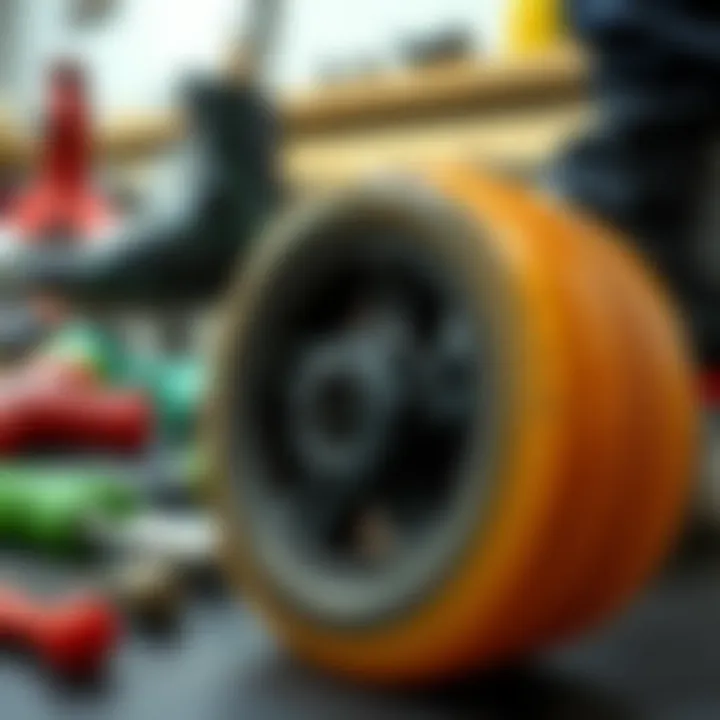
Building Connections Among Skaters
When you lace up your skates, you’re stepping into a world filled with potential friendships and collaborations. Building connections is as vital as mastering any trick or routine. Across different platforms—be it social media, local skate parks, or community events—skaters can forge bonds that elevate their experience.
Here are a few ways skaters can enhance their connections:
- Join Local Groups: Many cities have dedicated dance skating groups that organize meet-ups and practice sessions. This is a fantastic way to experience shared learning and camaraderie.
- Engage on Social Media: Platforms like Facebook and Instagram are buzzing with vibrant communities. Posting videos and engaging with others can lead to constructive feedback and collaborations.
- Attend Workshops: Skating workshops provide not only skill improvement but also opportunities to interact with fellow skaters. Many a friendship has sprouted during a shared struggle to nail a turn or solve a tricky spin.
"Skating isn’t just a movement; it’s an emotion. It brings us together, fuels our passion, and shapes our identity."
Events and Competitions
Events and competitions play a significant role in the dance skating community, creating an arena for skaters to showcase their talents and learn from one another. These gatherings are not merely contests; they are celebrations fostering community spirit and enthusiasm.
Competitions often draw in skaters of all skill levels, transforming spare parking lots or community centers into stages of artistry and athleticism. Observing the diversity in performance styles across different participants enriches everyone’s understanding of what dance skating involves. Competitions offer a platform where technique meets emotion, illustrating how each skater expresses their unique style.
Key Benefits of Participating in Events:
- Skill Development: Competing pushes skaters to refine their techniques, encouraging personal growth.
- Networking Opportunities: Events serve as a hub for meeting other skaters, coaches, and even sponsors.
- Cultural Exchange: Every event brings together skaters from different backgrounds, enriching the community’s culture through diverse styles and experiences.
In essence, the community and culture surrounding dance skating are as crucial as the wheels themselves, fueling a vibrant tapestry of support, creativity, and mutual growth. Engaging with this culture not only enhances skating skills but also builds lasting relationships, making each glide on the rink a cherished memory.
Trends in Dance Skate Wheels
Dance skating has evolved into a vibrant culture where creativity meets performance. As trends shift within this community, the evolution of dance skate wheels plays a pivotal role in shaping experiences for skaters at every level. Keeping abreast of these trends not only enhances the overall skating experience but also aligns with the broader currents in skating culture, enhancing both performance and self-expression.
Popularity of Customization
In recent years, customization has become a leading trend in the world of dance skate wheels. Nowadays, skaters are not just looking for performance; they want wheels that reflect their personal style. The idea is simple: if you can choose your colors, designs, and even materials, you can truly express yourself on wheels.
Customization grants skaters the freedom to choose wheels that match their skating style and environment. For instance, a skater who enjoys performances in well-lit rinks might prefer wheels in bright hues that catch the light. Others might select designs featuring fun patterns or even their names to stand out at competitions or community meets. This adds a layer of pride and individuality that can motivate skaters to express themselves more boldly.
Furthermore, many brands now offer customization options, taking into account not just aesthetics but also performance features like softness and grip. This trend is significant because it emphasizes individuality, allowing skaters to dance to their own beat—figuratively and literally.
Sustainability Considerations
The conversation around sustainability has permeated numerous industries, and dance skating is no exception. Skaters are becoming increasingly aware of the environmental impact of their gear, including their wheels. This awareness is leading to a notable trend towards sustainable materials and practices. Many brands are beginning to experiment with eco-friendly alternatives, such as wheels made from recycled materials or plant-based compounds.
This shift is crucial because it reflects a growing commitment among skaters to protect their environment while pursuing their passions. Sustainable practices not only appeal to eco-conscious consumers but also serve as a conversation starter within skate communities, promoting awareness and responsibility.
Organizations and brands are also launching initiatives to promote sustainability. For instance, they may offer recycling programs where old wheels can be returned and repurposed instead of ending up in landfills. This seamless integration of sustainability into the culture of dance skating signifies a collective movement towards a more environmentally responsible community.
The journey of innovations in dance skate wheels undoubtedly intertwines with trends that resonate with skaters’ values—be it self-expression through customization or a shared responsibility towards sustainability. Keeping an eye on these trends will allow skaters to enjoy a more informed and satisfying skating experience, reinforcing the sense of community in the process.
"Understanding these trends empowers skaters not just to perform better but to make meaningful choices that reflect their values." - A note from a veteran skater.
For further reading and in-depth analysis, visit Wikipedia or join discussions on platforms like Reddit and Facebook.
Skaters, bloggers, and coaches alike should pay attention to these trends, as they not only influence selection but also foster a dynamic skating environment.
Closure: The Future of Dance Skate Wheels
The journey of dance skate wheels is not just about the materials used or the engineering behind their creation; it's a reflection of the ongoing evolution of a vibrant skating community. Looking ahead, the future of dance skate wheels rests on innovation not only in terms of product design but also in the broader cultural shifts that surround the art of skating. With the increasing embrace of sustainability, customization, and advanced technology, we stand at the precipice of significant transformations.
Anticipated Innovations
- Sustainable Materials: As environmental awareness grows, manufacturers are exploring eco-friendly options for tire production. Expect to see an uptick in wheels made from recycled materials or biodegradable substances. Skaters increasingly demand products that minimize their carbon footprint, and brands will strive to meet this expectation.
- Technological Enhancements: Smart technology is sneaking into every aspect of our lives, and the skating world is no different. We might find wheels with embedded sensors to monitor wear and track performance metrics. This data can help in maintenance and even in refining skating techniques for both amateurs and pros.
- Customization Options: The notion of personalization will reach new heights. Advanced manufacturing processes, like 3D printing, could become mainstream, allowing skaters to design wheels that suit their individual style and skating preferences. Unique patterns, specific hardness levels, and tailored aesthetics will empower skaters to express themselves through their wheels.
- Improved Performance Features: Future designs will prioritize speed and grip through innovative shapes and surface textures. We might see wheels with layers that enhance shock absorption while maintaining a low rolling resistance, allowing dancers to glide smoothly and confidently.
"Innovation is not just about technology; it’s about improving the experience and fostering a deeper connection with the sport."
Final Thoughts on Community Impact
The evolution of dance skate wheels transcends mere functionality. As these innovations unfold, the skating community's culture will invariably change, fostering inclusivity and collaboration among skaters of all skill levels. This not only strengthens bonds within the community but also opens avenues for education and mentorship. Younger skaters can learn from seasoned ones, adapting the latest technologies while honoring traditions.
Moreover, these innovations encourage more people to engage with skating, as customizable and sustainable options may attract a diverse audience. This shared experience cultivates a sense of belonging, which is crucial in any community. The interactions during skate events, online forums, and social media platforms tie skaters together, forging friendships and artistic expressions that push the boundaries of dance skating further than ever before.
As the wheels roll into the future, one truth remains: the journey is just as impactful as the destination. The advancements in dance skate wheels will undoubtedly shape the artistry, performance, and community surrounding dance skating, keeping the heart of this culture alive and thriving.













